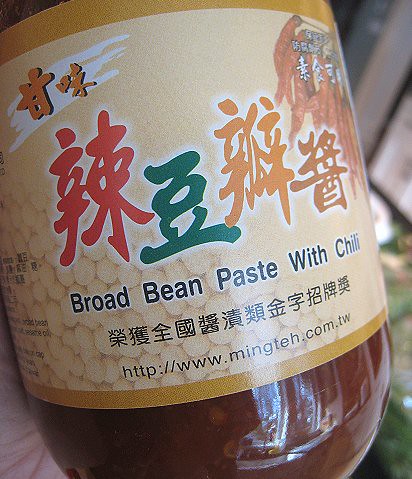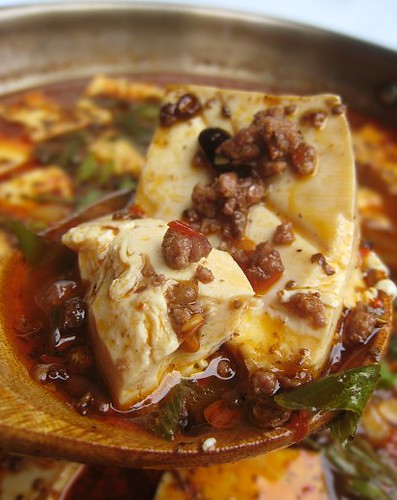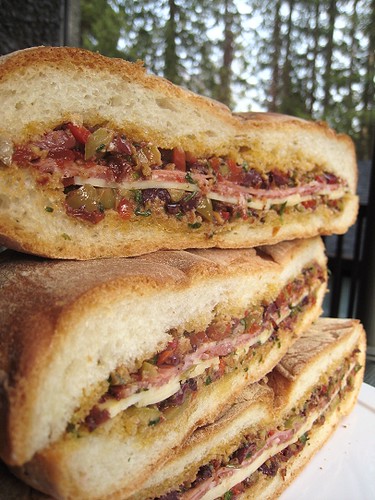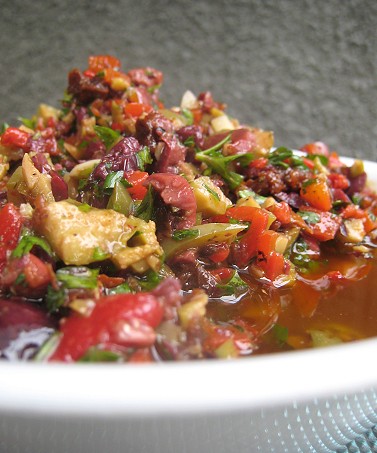
JS:
Ma po tofu is one of the most popular Chinese dishes around -- and I've eaten my fair share of ma po tofu over the years.
I hope I won't be losing my street cred here, but I must admit to liking ma po tofu in any guise. Around Vancouver, I've eaten and enjoyed ma po tofu in Cantonese restaurants and I've also ordered and enjoyed ma po tofu in Taiwanese restaurants.

JS:
Of course, these dishes bear only a passing resemblance to the Sichuanese, the supposed original. Surprisingly -- and how's this for a twist -- I haven't really enjoyed ma po tofu in any Sichuanese restaurants I've visited. Weird, wouldn't you say?
Wikipedia: Mapo doufu
So one day, I decided to try my hand at a home-cooked Sichuanese version of ma po tofu. I consulted Fuschia Dunlop's cookbook to start.
to start.
I was quite surprised that the recipe called for ground beef instead of ground pork. All my years eating ma po tofu, I've never had it with beef.
But, forged ahead I did.
"Specialty" Ingredients

TS:
First, some "specialty" ingredients are needed for this dish. One of these is Sichuan chili pepper flakes (四川辣椒).

四川辣椒 ("Sichuan chile pepper")TS:
I do not actually know what specific kind of chili pepper, except that it is usually labeled "Sichuan/Szechuan chili pepper". Best thing to do is go by the Chinese, as opposed to the English, description. These peppers do have quite a different aroma from regular chili flakes in regular supermarkets.

豆豉 (fermented black beans)
TS:
Another ingredient, probably not as unusual, is fermented black beans (豆豉).
These are the black beans in anything labeled "black bean sauce" on Chinese menus -- in Stir-fried Pork with Black Bean Sauce, for example. Or, the classic clams with black bean sauce. We have also used these before to quickly add flavor and seasoning to dishes, like in our Steamed Fish and Tofu with Chinese Black Beans.
About.com: Chinese Food - Fermented Black Beans

辣豆瓣醬 ("Broad Bean Paste with Chili")
TS:
My complaint about Fuchsia's book is that she does not include the Chinese names of the ingredients in her recipes. As some of you may have already experienced, describing something as "bean paste" is not very helpful at all!
Wikipedia: Doubanjiang
In the "Sichuanese Pantry" section of her book, she describes "chili bean paste" and includes the Chinese, 豆瓣醬 (dou ban jiang). She also includes a few sentences about a "Pixian bean paste" (no Chinese term included). However, in the actual recipe, she refers only to a "Sichuanese chili bean paste".
So, we used la doubanjiang (辣豆瓣醬), which is bean paste with chili.

郫县豆瓣酱 (Pixian bean paste)
JS:
It turns out, or I'm assuming, that I actually needed Pixian bean paste (郫县豆瓣酱), which is a tad different from the normal dou ban jiang (豆瓣醬) we use for other dishes. Pixian bean paste is a fermented broad bean paste, and boy is it potent!

花椒 (Sichuan peppercorns)
TS:
Of course, one must not forget Sichuan peppercorns (花椒)! They taste citrus-y, with an unmistakable numbing sensation.
JS roasted the Sichuan peppercorns first, then ground them in a mortar and pestle.
Wikipedia: Szechuan peppercorn

TS:
Fuchsia did not specify the type of tofu/bean curd needed for the dish! [sigh... Fuchsia.]
JS:
The recipe called for blanching the tofu, I think to get rid of the excess water. Well, given that I tend to be rough in handling tofu, I figure if I blanched them first, I would be left with curds. So, I simply cut them into large cubes.

TS:
JS went ahead and used ground pork. This was sautéed first, then the chili bean paste was added. We used both the doubanjiang with chili (辣豆瓣醬) and the Pixian bean paste (郫县豆瓣酱). The fermented black beans (豆豉) and the chili flakes (四川辣椒) went in next.
At this point, the oil should be a nice red color from the bean paste(s) and the chili flakes.
The recipe calls for adding stock, then the tofu. The whole lot is seasoned with sugar, soy sauce and salt, then simmered for a few minutes.
To get a nice luxurious consistency to the sauce, a cornstarch slurry (cornstarch dissolved in cold water) is used. Then, sliced baby leeks, or green onions in our case, and the ground roasted Sichuan peppercorn (花椒) are the finishing touches to the dish.

JS:
This version of ma po tofu turned out to be more watery than I wanted. One reason may be because I skipped the tofu-blanching in the beginning. But I also think that there was too much chicken stock in the recipe. I suppose I could have let the dish reduce further but impatience got the better of me. I turned off the stove and served my slightly watery ma po tofu.
I was also quite disappointed with the heat level in the dish, or the lack thereof. Fuchsia warned us that adding the ground Sichuanese chiles was "only for chile fiends", but this dish was not hot at all! Well, it all ended well, I suppose, as the kiddies also ate this up.
Our first Sichuan Mapo Tofu was still delicious, despite its shortcomings. But I know what to do, or what not to do, next time.
TS:
P.S. I've included the Chinese terms in the recipe below for ease in looking for ingredients.

eatingclub Sichuan/Sichuan-inspired (Szechuan)
Red Chile Oil (紅油)
Sichuan Peppercorn Chili Oil
Spicy Sweet Sichuan Popcorn
Gong Bao ("Kung Pao") Chicken (宮保雞丁)
Eggplant Dandan Mian (擔擔麵)
Sichuan "Crossed Hands" Wonton Dumplings 抄手, Two Ways (in Broth and with Chili Oil Sauce)
Sichuan Ma Po Tofu (麻婆豆腐)
Water Boil Fish (水煮魚) or Water Boil Beef (水煮牛肉)
Recipe
Pock-marked Mother Chen's Bean Curd
from Fuchsia Dunlop's Land of Plenty: A Treasury of Authentic Sichuan Cooking our notes/comments in green
our notes/comments in green
Serves 2-3 as a main course with one vegetable dish and rice, 4 with three other dishes
1 block bean curd (about 1 pound)
we used soft tofu
4 baby leeks or 2 leeks
we used green onions
1/2 cup peanut oil
6 ounces ground beef
we used ground pork
2-1/2 tablespoons Sichuanese chili bean paste
we used both chili bean paste (la doubanjiang, 辣豆瓣醬) and the Pixian bean paste (郫县豆瓣酱)
1 tablespoon fermented black beans
(豆豉)
2 teaspoons ground Sichuanese chiles (only for chile fiends)
(四川辣椒)
1 cup "everyday stock" or chicken stock
we would use less liquid next time
1 teaspoon white sugar
2 teaspoons light soy sauce
salt to taste
4 tablespoons cornstarch mixed with 6 tablespoons cold water
1/2 teaspoon ground roasted Sichuan pepper
(花椒)
1 Cut the bean curd into 1-inch cubes and leave to steep in very hot or gently simmering water that you have lightly salted. Slice the leeks at a steep angle into thin "horse ear" slices 1-1/2 inches long.
2 Season the wok, then add the peanut oil and heat over a high flame until smoking. Add the minced beef and stir-fry until it is crispy and a little brown, but not yet dry.
3 Turn the heat down to medium, add the chili bean paste and stir-fry for about 30 seconds, until the oil is a rich red color. Add the fermented black beans and ground chiles and stir-fry for another 20-30 seconds until they are both fragrant and the chiles have added their color to the oil.
4 Pour in the stock, stir well, and add the drained bean curd. Mix it in gently by pushing the back of your ladle or wok scoop gently from the edges to the center of the wok -- do not stir or the bean curd may break up. Season with the sugar, a couple of teaspoons of soy sauce, and salt to taste. Simmer for about 5 minutes, until the bean curd has absorbed the flavors of the sauce.
5 Add the leeks or scallions and gently stir in. When they are just cooked, add the cornstarch mixture in two or three stages, mixing well, until the sauce has thickened enough to cling glossily to the meat and bean curd. Don't add more than you need. Finally, pour everything into a deep bowl, scatter with ground Sichuan pepper, and serve.
































 Recipe
Recipe















